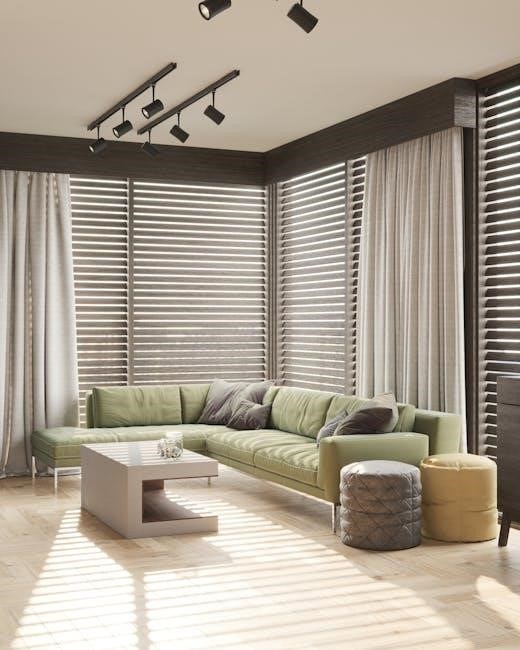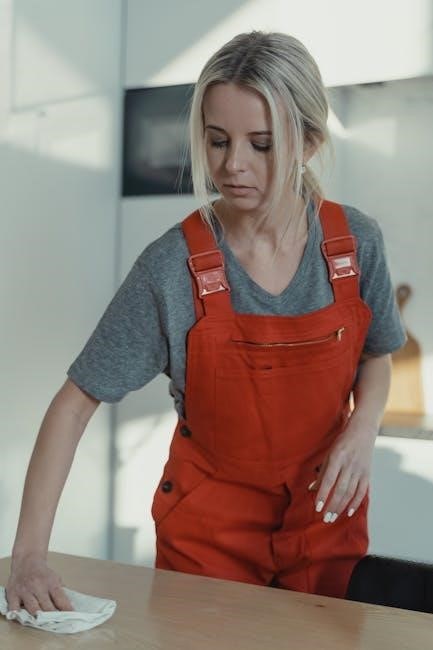Manual of Biogenic House Sections introduces innovative approaches to sustainable house design using biogenic materials and life cycle diagrams to create healthier living spaces with reduced carbon footprint naturally.
Overview of the Book
The Manual of Biogenic House Sections is a comprehensive guide that explores the potential of biogenic materials in house design‚ presenting a new approach to sustainable architecture.
The book is organized by material‚ featuring wood‚ bamboo‚ straw‚ hemp‚ cork‚ earth‚ brick‚ stone‚ and reuse‚ and includes life cycle diagrams that demonstrate how raw materials are processed into building components.
This organization allows readers to understand the unique properties of each material and how they can be used to transform the design of houses.
The book builds on the principles of sustainable design‚ providing a framework for creating healthier living spaces that reduce or sequester carbon‚ engage regenerative life cycles‚ and promote innovative approaches to house design.
The authors’ approach is rooted in their previous work‚ and this book represents a significant contribution to the field of sustainable architecture‚ offering a wealth of information and inspiration for architects‚ designers‚ and anyone interested in sustainable house design.

Biogenic Materials and Their Applications
Biogenic materials like wood‚ bamboo‚ and straw are used in innovative applications for sustainable house design naturally.
Types of Biogenic Materials
Various types of biogenic materials are being utilized in the construction of sustainable houses‚ including wood‚ bamboo‚ straw‚ hemp‚ cork‚ earth‚ brick‚ stone‚ and re-use materials.
These materials are organized based on their properties and life cycle diagrams‚ demonstrating how they can be processed into building components.
The unique characteristics of each material can transform the ways architects design and build houses‚ reducing or sequestering carbon and creating healthier living spaces.
The use of biogenic materials also engages regenerative life cycles‚ promoting a more sustainable approach to house design.
By exploring the different types of biogenic materials‚ architects and designers can develop innovative solutions for sustainable house design‚ ultimately reducing the environmental impact of buildings.
This approach can catalyze new types of houses that not only reduce carbon footprint but also provide healthier spaces for living‚ making it an essential aspect of the manual of biogenic house sections.

Design Strategies and Techniques
Architects employ various design strategies and techniques to create sustainable houses using biogenic materials effectively and efficiently always.
Life Cycle Diagrams and Material Processing
Life cycle diagrams are essential in understanding the processing of biogenic materials‚ from raw material extraction to end-of-life recycling or reuse‚ in the context of manual of biogenic house sections.
The diagrams illustrate the various stages of material processing‚ including harvesting‚ manufacturing‚ and installation‚ to provide a comprehensive understanding of the material’s life cycle.
Organized by material type‚ such as wood‚ bamboo‚ and straw‚ the diagrams demonstrate how each material can be processed and utilized in constructing sustainable houses.
This information enables architects and designers to make informed decisions about material selection and processing‚ ultimately reducing the environmental impact of their designs.
By examining the life cycle diagrams and material processing‚ designers can identify opportunities to reduce waste‚ minimize environmental degradation‚ and create healthier living spaces.
The manual of biogenic house sections provides a valuable resource for architects and designers seeking to create sustainable and environmentally conscious designs.

Relationship to Previous Work
Manual of Biogenic House Sections builds upon previous architectural publications naturally.
Sequel to Manual of Section
Manual of Biogenic House Sections is a sequel to the acclaimed Manual of Section‚ published in 2016. The book represents a continuation of the authors’ research on innovative architectural designs.
The new publication focuses on biogenic materials and their applications in sustainable house design‚ providing a comprehensive guide for architects and designers.
The authors’ approach to sustainable design is showcased through various case studies and life cycle diagrams‚ demonstrating the potential of biogenic materials to reduce carbon footprint and create healthier living spaces.
The book is organized by material type‚ including wood‚ bamboo‚ and straw‚ and explores how these materials can be used to create innovative and sustainable house designs.
The sequel builds upon the success of the original Manual of Section‚ offering a fresh perspective on sustainable design and biogenic materials.
The authors’ work has been widely recognized‚ and their publications have become essential resources for architects and designers seeking to create sustainable and innovative buildings.
The Manual of Biogenic House Sections is a valuable addition to the field of architecture‚ providing a comprehensive guide to sustainable design and biogenic materials.
The book’s focus on biogenic materials and sustainable design makes it a unique and important contribution to the field.
The authors’ research and expertise in the field of architecture are evident throughout the book‚ making it a valuable resource for professionals and students alike.
The Manual of Biogenic House Sections is a must-read for anyone interested in sustainable design and biogenic materials.
The book’s innovative approach to sustainable design and its focus on biogenic materials make it a groundbreaking publication in the field of architecture.
The authors’ commitment to sustainability and innovation is evident throughout the book‚ and their work has the potential to inspire a new generation of architects and designers.
The Manual of Biogenic House Sections is a significant contribution to the field of architecture‚ and its impact will be felt for years to come.
The book’s success is a testament to the authors’ dedication to sustainable design and their passion for creating innovative and sustainable buildings.
The Manual of Biogenic House Sections is an essential resource for anyone interested in sustainable design and biogenic materials‚ and its influence will be felt throughout the architectural community.
The authors’ work on the Manual of Biogenic House Sections has been widely recognized‚ and the book has received critical acclaim from architects and designers around the world.
The book’s innovative approach to sustainable design and its focus on biogenic materials have made it a landmark publication in the field of architecture.
The Manual of Biogenic House Sections is a valuable resource for professionals and students alike‚ and its impact will be felt for years to come.

and Future Directions
Manual of Biogenic House Sections concludes with future directions for sustainable house design using biogenic materials and regenerative life cycles to create healthier living spaces naturally every day.
Implications for Sustainable House Design
The Manual of Biogenic House Sections has significant implications for sustainable house design‚ as it showcases the potential of biogenic materials to reduce carbon footprint and create healthier living spaces.
The book’s focus on life cycle diagrams and material processing highlights the importance of considering the entire lifecycle of a building‚ from construction to demolition.
By using biogenic materials and regenerative life cycles‚ architects and designers can create sustainable houses that not only reduce environmental impact but also promote occupant health and well-being.
The manual’s innovative approaches to sustainable house design have far-reaching implications for the built environment‚ and its principles can be applied to a wide range of building types and contexts.
Overall‚ the Manual of Biogenic House Sections is a valuable resource for anyone interested in sustainable design and its potential to transform the way we build and live.

